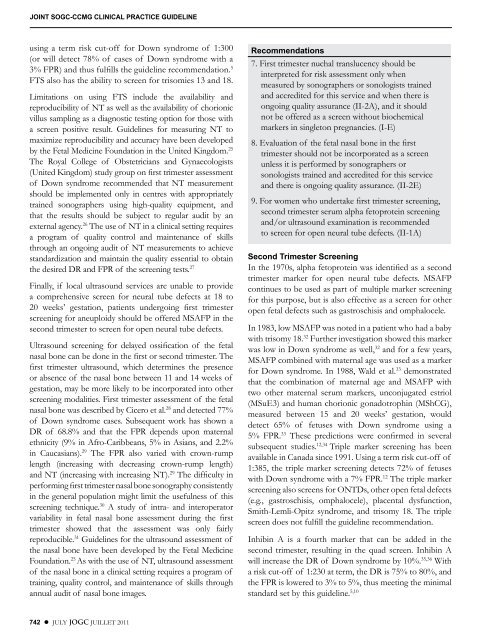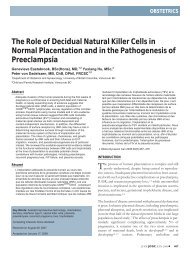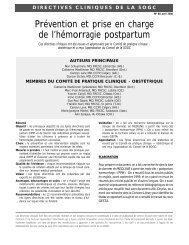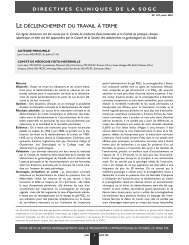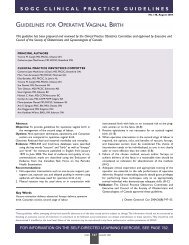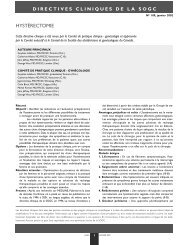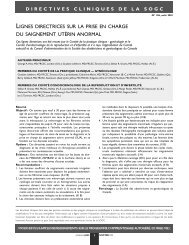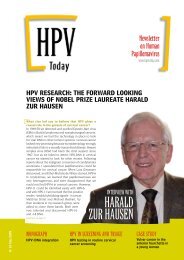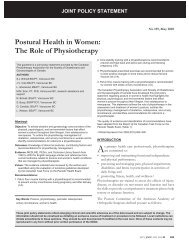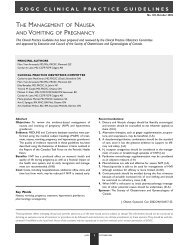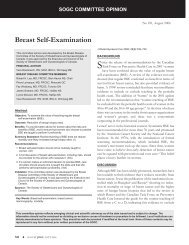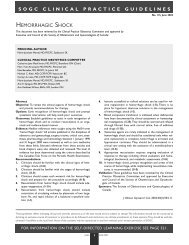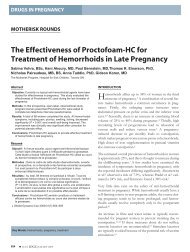Prenatal Screening for Fetal Aneuploidy in Singleton ... - SOGC
Prenatal Screening for Fetal Aneuploidy in Singleton ... - SOGC
Prenatal Screening for Fetal Aneuploidy in Singleton ... - SOGC
Create successful ePaper yourself
Turn your PDF publications into a flip-book with our unique Google optimized e-Paper software.
JOINT <strong>SOGC</strong>-CCMG CLINICAL PRACTICE GuIDELINE<br />
us<strong>in</strong>g a term risk cut-off <strong>for</strong> Down syndrome of 1:300<br />
(or will detect 78% of cases of Down syndrome with a<br />
3% FPR) and thus fulfills the guidel<strong>in</strong>e recommendation. 5<br />
FTS also has the ability to screen <strong>for</strong> trisomies 13 and 18.<br />
Limitations on us<strong>in</strong>g FTS <strong>in</strong>clude the availability and<br />
reproducibility of NT as well as the availability of chorionic<br />
villus sampl<strong>in</strong>g as a diagnostic test<strong>in</strong>g option <strong>for</strong> those with<br />
a screen positive result. Guidel<strong>in</strong>es <strong>for</strong> measur<strong>in</strong>g NT to<br />
maximize reproducibility and accuracy have been developed<br />
by the <strong>Fetal</strong> Medic<strong>in</strong>e Foundation <strong>in</strong> the United K<strong>in</strong>gdom. 25<br />
The Royal College of Obstetricians and Gynaecologists<br />
(United K<strong>in</strong>gdom) study group on first trimester assessment<br />
of Down syndrome recommended that NT measurement<br />
should be implemented only <strong>in</strong> centres with appropriately<br />
tra<strong>in</strong>ed sonographers us<strong>in</strong>g high-quality equipment, and<br />
that the results should be subject to regular audit by an<br />
external agency. 26 The use of NT <strong>in</strong> a cl<strong>in</strong>ical sett<strong>in</strong>g requires<br />
a program of quality control and ma<strong>in</strong>tenance of skills<br />
through an ongo<strong>in</strong>g audit of NT measurements to achieve<br />
standardization and ma<strong>in</strong>ta<strong>in</strong> the quality essential to obta<strong>in</strong><br />
the desired DR and FPR of the screen<strong>in</strong>g tests. 27<br />
F<strong>in</strong>ally, if local ultrasound services are unable to provide<br />
a comprehensive screen <strong>for</strong> neural tube defects at 18 to<br />
20 weeks’ gestation, patients undergo<strong>in</strong>g first trimester<br />
screen<strong>in</strong>g <strong>for</strong> aneuploidy should be offered MSAFP <strong>in</strong> the<br />
second trimester to screen <strong>for</strong> open neural tube defects.<br />
Ultrasound screen<strong>in</strong>g <strong>for</strong> delayed ossification of the fetal<br />
nasal bone can be done <strong>in</strong> the first or second trimester. The<br />
first trimester ultrasound, which determ<strong>in</strong>es the presence<br />
or absence of the nasal bone between 11 and 14 weeks of<br />
gestation, may be more likely to be <strong>in</strong>corporated <strong>in</strong>to other<br />
screen<strong>in</strong>g modalities. First trimester assessment of the fetal<br />
nasal bone was described by Cicero et al. 28 and detected 77%<br />
of Down syndrome cases. Subsequent work has shown a<br />
DR of 68.8% and that the FPR depends upon maternal<br />
ethnicity (9% <strong>in</strong> Afro-Caribbeans, 5% <strong>in</strong> Asians, and 2.2%<br />
<strong>in</strong> Caucasians). 29 The FPR also varied with crown-rump<br />
length (<strong>in</strong>creas<strong>in</strong>g with decreas<strong>in</strong>g crown-rump length)<br />
and NT (<strong>in</strong>creas<strong>in</strong>g with <strong>in</strong>creas<strong>in</strong>g NT). 29 The difficulty <strong>in</strong><br />
per<strong>for</strong>m<strong>in</strong>g first trimester nasal bone sonography consistently<br />
<strong>in</strong> the general population might limit the usefulness of this<br />
screen<strong>in</strong>g technique. 30 A study of <strong>in</strong>tra- and <strong>in</strong>teroperator<br />
variability <strong>in</strong> fetal nasal bone assessment dur<strong>in</strong>g the first<br />
trimester showed that the assessment was only fairly<br />
reproducible. 31 Guidel<strong>in</strong>es <strong>for</strong> the ultrasound assessment of<br />
the nasal bone have been developed by the <strong>Fetal</strong> Medic<strong>in</strong>e<br />
Foundation. 25 As with the use of NT, ultrasound assessment<br />
of the nasal bone <strong>in</strong> a cl<strong>in</strong>ical sett<strong>in</strong>g requires a program of<br />
tra<strong>in</strong><strong>in</strong>g, quality control, and ma<strong>in</strong>tenance of skills through<br />
annual audit of nasal bone images.<br />
742 l JULY JOGC JUILLET 2011<br />
Recommendations<br />
7. First trimester nuchal translucency should be<br />
<strong>in</strong>terpreted <strong>for</strong> risk assessment only when<br />
measured by sonographers or sonologists tra<strong>in</strong>ed<br />
and accredited <strong>for</strong> this service and when there is<br />
ongo<strong>in</strong>g quality assurance (II-2A), and it should<br />
not be offered as a screen without biochemical<br />
markers <strong>in</strong> s<strong>in</strong>gleton pregnancies. (I-E)<br />
8. Evaluation of the fetal nasal bone <strong>in</strong> the first<br />
trimester should not be <strong>in</strong>corporated as a screen<br />
unless it is per<strong>for</strong>med by sonographers or<br />
sonologists tra<strong>in</strong>ed and accredited <strong>for</strong> this service<br />
and there is ongo<strong>in</strong>g quality assurance. (II-2E)<br />
9. For women who undertake first trimester screen<strong>in</strong>g,<br />
second trimester serum alpha fetoprote<strong>in</strong> screen<strong>in</strong>g<br />
and/or ultrasound exam<strong>in</strong>ation is recommended<br />
to screen <strong>for</strong> open neural tube defects. (II-1A)<br />
Second Trimester <strong>Screen<strong>in</strong>g</strong><br />
In the 1970s, alpha fetoprote<strong>in</strong> was identified as a second<br />
trimester marker <strong>for</strong> open neural tube defects. MSAFP<br />
cont<strong>in</strong>ues to be used as part of multiple marker screen<strong>in</strong>g<br />
<strong>for</strong> this purpose, but is also effective as a screen <strong>for</strong> other<br />
open fetal defects such as gastroschisis and omphalocele.<br />
In 1983, low MSAFP was noted <strong>in</strong> a patient who had a baby<br />
with trisomy 18. 32 Further <strong>in</strong>vestigation showed this marker<br />
was low <strong>in</strong> Down syndrome as well, 32 and <strong>for</strong> a few years,<br />
MSAFP comb<strong>in</strong>ed with maternal age was used as a marker<br />
<strong>for</strong> Down syndrome. In 1988, Wald et al. 33 demonstrated<br />
that the comb<strong>in</strong>ation of maternal age and MSAFP with<br />
two other maternal serum markers, unconjugated estriol<br />
(MSuE3) and human chorionic gonadotroph<strong>in</strong> (MShCG),<br />
measured between 15 and 20 weeks’ gestation, would<br />
detect 65% of fetuses with Down syndrome us<strong>in</strong>g a<br />
5% FPR. 33 These predictions were confirmed <strong>in</strong> several<br />
subsequent studies. 12,34 Triple marker screen<strong>in</strong>g has been<br />
available <strong>in</strong> Canada s<strong>in</strong>ce 1991. Us<strong>in</strong>g a term risk cut-off of<br />
1:385, the triple marker screen<strong>in</strong>g detects 72% of fetuses<br />
with Down syndrome with a 7% FPR. 12 The triple marker<br />
screen<strong>in</strong>g also screens <strong>for</strong> ONTDs, other open fetal defects<br />
(e.g., gastroschisis, omphalocele), placental dysfunction,<br />
Smith-Lemli-Opitz syndrome, and trisomy 18. The triple<br />
screen does not fulfill the guidel<strong>in</strong>e recommendation.<br />
Inhib<strong>in</strong> A is a fourth marker that can be added <strong>in</strong> the<br />
second trimester, result<strong>in</strong>g <strong>in</strong> the quad screen. Inhib<strong>in</strong> A<br />
will <strong>in</strong>crease the DR of Down syndrome by 10%. 35,36 With<br />
a risk cut-off of 1:230 at term, the DR is 75% to 80%, and<br />
the FPR is lowered to 3% to 5%, thus meet<strong>in</strong>g the m<strong>in</strong>imal<br />
standard set by this guidel<strong>in</strong>e. 5,10


